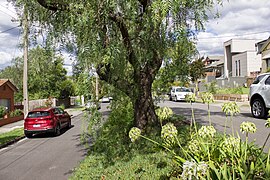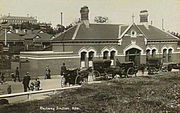Kew, Victoria
| Kew Melbourne,Victoria | |||||||||||||||
|---|---|---|---|---|---|---|---|---|---|---|---|---|---|---|---|
 Kellett Grove, Kew | |||||||||||||||
 | |||||||||||||||
| Coordinates | 37°48′19″S145°2′9″E/ 37.80528°S 145.03583°E | ||||||||||||||
| Population | 24,499 (SAL2021)[1] | ||||||||||||||
| Postcode(s) | 3101 | ||||||||||||||
| Elevation | 58 m (190 ft) | ||||||||||||||
| Area | 10.5 km2(4.1 sq mi) | ||||||||||||||
| Location | 6 km (4 mi) fromMelbourne | ||||||||||||||
| LGA(s) | City of Boroondara | ||||||||||||||
| State electorate(s) | Kew | ||||||||||||||
| Federal division(s) | Kooyong | ||||||||||||||
| |||||||||||||||
Kew(/kjuː/) is a suburb ofMelbourne,Victoria,Australia,found 5 km east from Melbourne'sCentral Business District.Kew is located within theCity of Boroondaralocal government area.Kew recorded a population of 24,499 at the2021 census.[2]
A city in its own rightfrom 1860 to 1994, Kew was amalgamated with the cities ofHawthornandCamberwellto form the City of Boroondara. The suburb borders theYarra Riverto the west and northwest, withKew Eastto the northeast,HawthornandHawthorn Eastto its south, and withBalwyn,Balwyn NorthandDeepdeneto the east.
History
[edit]Prior to the establishment of Melbourne, the area was inhabited by theWurundjeripeoples. In the 1840s European settlers named it the Parish ofBoroondara– meaning "a place of shade" in the Woiwurrung language. In 1838 Dight travelled down the Yarra fromHeidelbergand decided to locate a water-powered mill on a site adjacent toDights Falls;the impressive three-storey mill opened in 1840.[3]
John Hodgsonestablished a squatters run at Studley Park, on the eastern bank of the Yarra River, in 1840.Studley House,also known asBurke Hall,built in 1857, was named after Hodgson's birthplace of Studley,Yorkshireand the house is now on the Register of the National Estate.[4]The house was built in the Victorian PeriodItalianateRevival style. Modifications were made to the house in 1875 and 1919. The house was also owned by former bookmaker,ALPlobbyist, influential Irish-Catholic and millionaire,John Wrenand was donated toXavier Collegeby the land developer,Thomas Burke.It illustrates the importance of a residence in indicating success and status in nineteenth- and early-twentieth-century Melbourne society. The nearbyVilla Alba,built before 1863,[5]is open to the public.[6]
In 1851,Crown landsales occurred in the area. One of the purchasers, Nicholas Fenwick, subdivided his land (which was just further out from the centre of the colony of Melbourne than the area known asRichmond) and named the region Kew, based on the thought thatKewin England was nearRichmond.He also notably named its streets after British statesmen. The area quickly became a sought-after suburb for the well-to-do in Melbourne. Access to Kew was originally viaBridge Roadin Richmond, crossing theHawthorn Bridgeto Burwood Road, until the privately owned Studley Park Bridge (nicknamed thePenny Bridge) opened in 1857,[7]connecting Church Street Richmond with Studley Park.
The commercial precinct known as Kew Junction began to take shape in the 1850s. The first store was opened by Mr. J. J. French in August 1853 and the first post office on 6 October 1856,[8]however, it was not till towards the end of the decade that many shops appeared in High Street. The Kew Hotel opened in 1855, the Prospect Hill Hotel (now theDan Murphy'sliquor store) in 1857, the Council Hotel about 1860, the Clifton (now Hotel Kew) in 1869 and the Greyhound (now the Skinny Dog Hotel) in 1874. The block of civic buildings comprising the former post office, the former court house and the former police station were built in 1888 as was theNational Bank,at the corner of Walpole and High Streets.[9]
In 1856, a site was reserved for a mental asylum next to the river. By 1871Kew Lunatic Asylum,now known asWillsmere Estate,was completed. TheKew Cottagesfor children were added in 1887. The hospital was built despite objections by residents and the Kew Borough Council[10]and provides an historical example ofnimbyism.Kew Cottagesand Willsmere Hospital are listed on theVictorian Heritage Register.
Various churches opened in the 1850s, with the first school opened by the Anglican Church in 1856.[11]In 1875Sacred Heart Primary Schoolwas opened. More private schools were opened in 1878, includingRuyton Girls' School(non-denominational) andXavier College(CatholicinJesuitorder). Other private schools soon followed, includingMethodist Ladies' College(Uniting Church in Australia) in 1882,Genazzano FCJ Collegein 1889,Trinity Grammar School(Anglican) in 1903, andCarey Baptist Grammar School(Baptist) in 1923.Preshil,The Margaret Lyttle Memorial School, was opened in the early 1930s. In 1960 it was said: "it would be difficult to find any locality so richly endowed with so many and such large educational institutions as are to be found in Kew."[12]
Arailway branch line to KewfromHawthorn Stationopened on 19 December 1887 and was officially closed on 13 May 1957.[13]Kew was proclaimed a town on 8 December 1910, and a city on 10 March 1921. The population of the area tripled between 1910 andWorld War II.
A former house in Kew was the birthplace of the 21stPrime Minister of Australia,Gough Whitlam.As of 2016, due to its demolition, the house no longer exists.
Raheen
[edit]Raheenis a historic 19th-century Italianate mansion, located at 92 Studley Park Road. It was built in the 1870s,[14]and its name means "little fort" in Irish.
Raheen was once the residence ofDaniel Mannix,the former CatholicArchbishop of Melbourne[15]and was purchased by theCatholic Churchin 1917 with support fromJohn Wren.
It was purchased in 1980 by the Australian businessmanRichard Prattand his family and is not currently open to the public. Pratt extensively renovated the house and gardens, including the addition of a new wing, designed byGlen Murcutt.[14]
Today
[edit]Kew has grown steadily since the early Bridge Road crossing development and is cited as one of the most prestigious suburbs in Melbourne.[16]As a consequence, many of these residences now attract some of the highest residential resale values in Melbourne.[17]
Streets in theSackville Ward(bounded by Barkers, Burke, Cotham and Glenferrie Roads), such as Alfred, Rowland, Wellington, Grange and Sackville, have some exceptional examples ofEdwardian,Victorianand contemporary architecture.
The suburb has been home to numerous Scout Groups since 1st Kew was formed in 1909. Today, only 1st Kew and 4th Kew are in operation.
Kew has convenient access to public facilities and transport. The109,16and72along with tram route48(North Balwyn – Victoria Harbour Docklands)tram routespass through the suburb and the City/Lilydale/Belgravetrain line is easily accessed atHawthornandGlenferrieStations.Kew Stationand theassociated railway branchwas last served by passenger trains in 1952,[13]with the station site now the headquarters ofVicRoads.
-
Looking towards the formerKew Asylum,now known as Willsmere Estate
-
Aerial view over northern residential parts of Kew looking southwest showingStudley Park(top),Kew Asylum(right) andEastern FreewayEarl Street exit (bottom right)
-
The street side of the former Kew station.Xavier Collegein background.
Demographics
[edit]| Year | Pop. | ±% |
|---|---|---|
| 2001 | 22,689 | — |
| 2006 | 22,516 | −0.8% |
| 2011 | 23,876 | +6.0% |
| 2016 | 24,605 | +3.1% |
| 2021 | 24,499 | −0.4% |
In the 2021 Census, there were 24,499 people in Kew. 66.1% of people were born in Australia. The next most common countries of birth were China 6.6%, England 2.9%, Malaysia 2.2%, India 1.8% and New Zealand 1.4%. 70.3% of people spoke only English at home. Other languages spoken at home included Mandarin 8.6%, Greek 3.0%, Cantonese 2.8%, Italian 1.7% and Vietnamese 1.4%. The most common responses for religion were No Religion 44.1% and Catholic 22.7%.[18]
Education
[edit]- Kew Primary School
- Sacred Heart Primary School
- Carey Baptist Grammar School
- Genazzano FCJ College
- Methodist Ladies' College
- Preshil
- Ruyton Girls' School
- Trinity Grammar School
- Xavier College
- Kew High School
Sport
[edit]Golfers have the choice of membership at Green Acres Golf Club,[19]or Kew Golf Club, inKew East,[20]or may play at the Studley Park Par 3 Golf Course, on Studley Park Road.[21]
Kew Football Cluband Kew Cricket Club play out of Victoria Park, on High Street.
Notable people
[edit]
- Phil Anderson– cyclist
- Cecil Austen– footballer
- Jack Billings– AFL footballer
- Philip Brady– 3AW radio personality
- MacFarlane Burnet– virologist andNobel Laureate
- Irene Crespin– Geologist
- Peter Curran– footballer
- Robert DiPierdomenico– footballer
- Cathy Freeman[22]
- Josh Frydenberg– politician
- Andrew Gaff– AFL footballer-played junior football for Kew Comets
- Jack Gervasoni– footballer and Mayor of Kew
- Robin Gray– Premier of Tasmania
- Rupert Hamer– Premier of Victoria
- Terrence Hodson– Murdered Police Informant and Drug Dealer
- Walter Reginald Hume– businessman and inventor
- Barry Humphries– comedian, actor, author and satirist
- Brian V. Johnstone–theologian
- Graham Kinniburgh– organised crime figure
- Michael Klinger– cricketer
- Peter MacCallum– pathologist
- Jack Macrae– AFL footballer
- Glenn Maxwell– cricketer
- Luke McDonald– AFL footballer
- Peter McIntyre– architect
- Clement Roy Nichols– Scouting
- Gustav Nossal– scientist andAustralian of the Year
- Phil Ryan– footballer
- Jack Sinclair– AFL footballer-played junior football for Kew Comets
- Wendy Smith (politician)– politician
- Ross Stevenson– 3AW radio presenter
- David Syme– owner ofThe Ageand associated newspapers
- Frank T. M. White– mineral science educator
- Gough Whitlam– 21stPrime Minister of Australiaborn at'Ngara' 46 Rowland St.
- John Wren– businessman
See also
[edit]- City of Kew– Kew was previously within this former local government area.
- Electoral district of Kew- The state electoral division in which encompasses the suburb of Kew.
- Division of Kooyong- The federal electoral division in which encompasses the suburb of Kew.
- City of Boroondara- The local government council in which encompasses the suburb of Kew.
References
[edit]- ^Australian Bureau of Statistics(28 June 2022)."Kew (Vic.) (suburb and locality)".Australian Census 2021 QuickStats.Retrieved28 June2022.
- ^Australian Bureau of Statistics(28 June 2022)."Kew (Vic.) (Suburbs and Localities)".2021 Census QuickStats.Retrieved3 July2022.
- ^"St. Paul's Anglican Church Online History".Archived fromthe originalon 27 September 2007.Retrieved30 April2007.
- ^"Studley House, Victorian Heritage Register (VHR) Number H0789, Heritage Overlay HO101".Victorian Heritage Database.Heritage Victoria.
- ^"Villa Alba, Victorian Heritage Register (VHR) Number H0605, Heritage Overlay HO134".Victorian Heritage Database.Heritage Victoria.
- ^"Villa Alba Museum – Villa Alba Museum – Kew, Victoria, Australia".
- ^"OPENING OF STUDLEY PARK BRIDGE".The Argus.Melbourne: National Library of Australia. 6 June 1857. p. 6.Retrieved3 January2012.
- ^Premier Postal History."Post Office List".Retrieved11 April2008.
- ^"The Jubilee History of Kew, Victoria: Its Origin and Progress".E.F.G. Hodges, "Mercury Office", 1910.Retrieved20 June2011.
- ^"And your petitioners humbly pray – Lunatic Asylum 1858".Public Records Office of Victoria. Archived fromthe originalon 17 August 2008.Retrieved7 September2008.
- ^Rogers p106
- ^Vaughan p163
- ^abS.E. Dornan and R.G. Henderson (1979).Electric Railways of Victoria.Australian Electric Traction Society.ISBN0-909459-06-1.
- ^ab"Raheen".17 March 2007 – via www.abc.net.au.
- ^James Kirby and Tony Stephens (obituary) "Tycoon with an immense, combative energy",Sydney Morning Herald,29 April 2009
- ^"Melbourne's prestige house market bounces back on million-dollar property deals".The Age.1 March 2014.Retrieved16 March2014.
- ^Tolhurst, Chris (14 April 2012)."Kew jumpers lead the dear hunters in finding a place in the dress circle".The Age.Retrieved16 March2014.
- ^"2021 Kew (Vic.), Census All persons QuickStats | Australian Bureau of Statistics".www.abs.gov.au.
- ^Golf Select."Green Acres".Retrieved5 January2012.
- ^Golf Select."Kew".Retrieved11 May2009.
- ^Golf Select."Studley Park".Retrieved11 May2009.
- ^"30 Yarravale Road, Kew, Vic 3101".realestate.com.au.16 February 2023.Retrieved17 February2023.
- "Kew, Victoria".Archived fromthe originalon 24 August 2006.Retrieved19 May2008.(viaInternet Archive)
Bibliography
[edit]- Rogers, Dorothy. "A History of Kew". Kilmore, Victoria:Lowden Publishing Co. 1973.ISBN0 909706 13 1.
- Vaughan, W.D. "Kew's Civic Century". Kew, Victoria, W.D.Vaughan Pty Ltd, First Edition 1960.
External links
[edit] Media related toKew, Victoriaat Wikimedia Commons
Media related toKew, Victoriaat Wikimedia Commons




